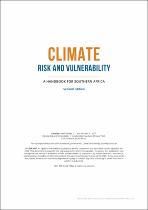JavaScript is disabled for your browser. Some features of this site may not work without it.
- ResearchSpace
- →
- Research Publications/Outputs
- →
- Book Chapters
- →
- View Item
| dc.contributor.author |
Davis-Reddy, Claire

|
|
| dc.date.accessioned | 2018-03-29T07:39:59Z | |
| dc.date.available | 2018-03-29T07:39:59Z | |
| dc.date.issued | 2017-10 | |
| dc.identifier.citation | Davis-Reddy, C. 2017. Terrestrial ecosystems and biodiversity. Climate Risk and Vulnerability: A Handbook for Southern Africa (2nd edition), p. 72-81 | en_US |
| dc.identifier.isbn | 978-0-620-76522-0 | |
| dc.identifier.uri | https://www.csir.co.za/sites/default/files/Documents/SADC%20Handbook_Second%20Edition_full%20report.pdf | |
| dc.identifier.uri | http://hdl.handle.net/10204/10152 | |
| dc.description | Chapter published in Climate Risk and Vulnerability: A Handbook for Southern Africa (2nd edition) | en_US |
| dc.description.abstract | Southern Africa has a rich diversity of plants and animals and its high levels of endemism are critical to cultural heritage and support livelihoods and economic development (e.g. ecotourism). Six of the 34 internationally identified biodiversity `hotspots¿ are located in southern Africa, namely the Cape Floristic Region, Succulent Karoo, Maputaland-Pondoland- Albany, Eastern Afromontane, Madagascar and the Indian Ocean Islands, and Coastal Forests of Eastern Africa. These `hotspots¿ contain high concentrations of endemic plant and animal species, but these mainly occur in areas that are most threatened by human activity. Changes in climate, combined with land-use change and the spread of invasive species, are likely to limit the resilience of the terrestrial ecosystems of southern Africa and contribute to biodiversity loss. | en_US |
| dc.language.iso | en | en_US |
| dc.publisher | CSIR. | en_US |
| dc.relation.ispartofseries | Worklist;20416 | |
| dc.subject | Biodiversity | en_US |
| dc.subject | Biome shifts | en_US |
| dc.subject | Ecosystem-based adaptation | en_US |
| dc.subject | Ecotourism | en_US |
| dc.subject | Invasive species | en_US |
| dc.subject | Land-use change | en_US |
| dc.title | Terrestrial ecosystems and biodiversity | en_US |
| dc.type | Book Chapter | en_US |
| dc.identifier.apacitation | Davis-Reddy, C. (2017). Terrestrial ecosystems and biodiversity., <i>Worklist;20416</i> CSIR.. http://hdl.handle.net/10204/10152 | en_ZA |
| dc.identifier.chicagocitation | Davis-Reddy, Claire. "Terrestrial ecosystems and biodiversity" In <i>WORKLIST;20416</i>, n.p.: CSIR.. 2017. http://hdl.handle.net/10204/10152. | en_ZA |
| dc.identifier.vancouvercitation | Davis-Reddy C. Terrestrial ecosystems and biodiversity.. Worklist;20416. [place unknown]: CSIR.; 2017. [cited yyyy month dd]. http://hdl.handle.net/10204/10152. | en_ZA |
| dc.identifier.ris | TY - Book Chapter AU - Davis-Reddy, Claire AB - Southern Africa has a rich diversity of plants and animals and its high levels of endemism are critical to cultural heritage and support livelihoods and economic development (e.g. ecotourism). Six of the 34 internationally identified biodiversity `hotspots¿ are located in southern Africa, namely the Cape Floristic Region, Succulent Karoo, Maputaland-Pondoland- Albany, Eastern Afromontane, Madagascar and the Indian Ocean Islands, and Coastal Forests of Eastern Africa. These `hotspots¿ contain high concentrations of endemic plant and animal species, but these mainly occur in areas that are most threatened by human activity. Changes in climate, combined with land-use change and the spread of invasive species, are likely to limit the resilience of the terrestrial ecosystems of southern Africa and contribute to biodiversity loss. DA - 2017-10 DB - ResearchSpace DP - CSIR KW - Biodiversity KW - Biome shifts KW - Ecosystem-based adaptation KW - Ecotourism KW - Invasive species KW - Land-use change LK - https://researchspace.csir.co.za PY - 2017 SM - 978-0-620-76522-0 T1 - Terrestrial ecosystems and biodiversity TI - Terrestrial ecosystems and biodiversity UR - http://hdl.handle.net/10204/10152 ER - | en_ZA |






